Bloodroot: An Understandable Misnomer
Posted in Science on April 20 2013, by Carol Gracie
After spending nearly three decades at the NYBG, and working much of that time in South American rainforests with her husband, Scott A. Mori, Carol Gracie has returned to one of her first botanical interests in retirement–local wildflowers. She is the author of Spring Wildflowers of the Northeast: A Natural History and coauthor (with Steve Clemants) of Wildflowers in the Field and Forest: A Field Guide to the Northeastern United States.
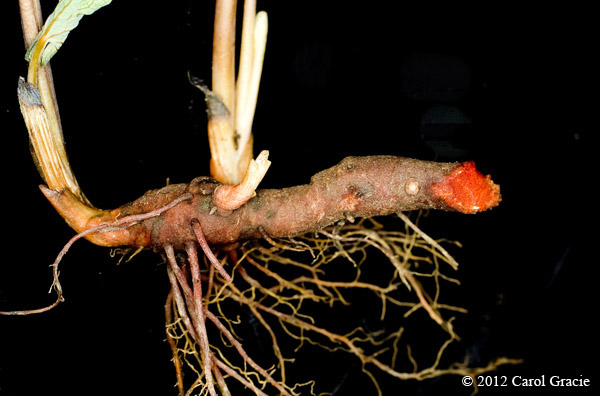
Both the scientific name, Sanguinaria canadensis, and the common name, bloodroot, of this spring wildflower are descriptive. The generic name Sanguinaria has its roots in the Latin word for blood, and bloodroot describes the root-like rhizome of this plant, which contains a bright red sap. Like other members of the poppy family, Papaveraceae, the sap throughout the plant is colored, which may be seen by breaking a vein in the leaf with your fingernail.
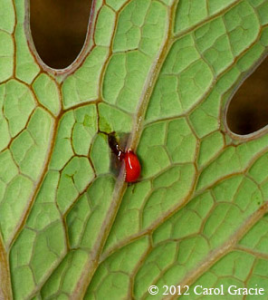
Bloodroot is a monotypic species. It is the only species in the genus Sanguinaria and differs from all other genera in the poppy subfamily Papaveroideae by having its flower stalks and leaves arising separately from the rhizome.
Native Americans used the colorful sap medicinally and as a dye for plant material and quills that were used in basketry, ornamentation, and body decoration. Some of these uses were adopted by the early colonists who used bloodroot to treat sore throats and asthma. More recently, in the early 1990s, a new usage was found for one component of the sap, the alkaloid sanguinarine.
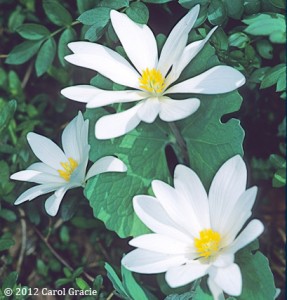
Sanguinarine showed effectiveness against the build-up of dental plaque and was incorporated into toothpaste and mouthwash. Advertisements depicting images of the flowers and rhizomes of bloodroot promoted the products as a natural remedy. However, after a few years it became evident that users of the dental products were developing white plaques in their mouths of a type that can progress to oral cancer. The products were quickly withdrawn, but the example provides a lesson that “natural” products are not necessarily harmless.
A typical bloodroot flower has eight petals, but flowers with 10-20 may be found in the wild. In this case, some of the stamens have been modified into petals. Those plants are somewhat showier and have found their way into horticulture as Sanguinaria canadensis ‘Flora Plena.’ Still others have undergone a genetic mutation that caused all of their stamens to become petals. These doubled flowers resemble miniature, doubled peonies and are favored among gardeners who know them as Sanguinaria canadensis ‘Multiplex.’
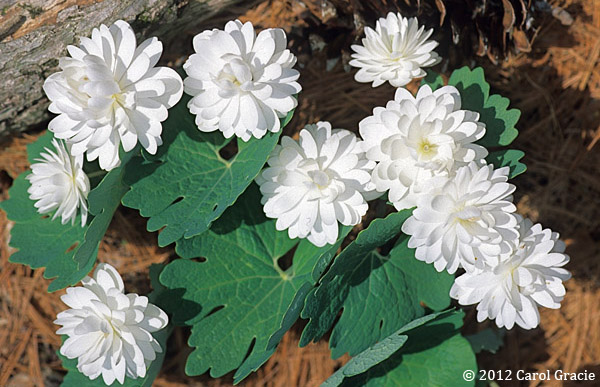
The Multiplex plants originate from one plant discovered in the woods of Ohio in 1916. Since there are no reproductive parts, all of these double-flowered plants must be propagated vegetatively. However, the lack of reproductive parts also results in these plants holding their petals for a much longer time than “normal” bloodroot plants, which quickly drop their petals after they have been pollinated.
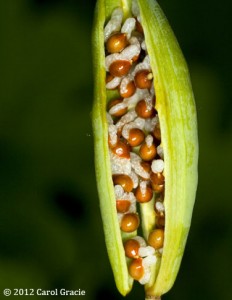
Spindle-shaped seedpods form beneath the large, attractive leaves, splitting open to release their seeds onto the ground. Like Dutchman’s breeches, the seeds of bloodroot have an oil-rich elaiosome attached, which attracts ants to serve as dispersal agents.
Learn more about bloodroot and other spring wildflowers in my book, Spring Wildflowers of the Northeast: A Natural History, available at Shop in the Garden. And be sure to see bloodroot, including the ‘Multiplex’ form, in the new Native Plant Garden during the Grand Opening Weekend, May 3–5, 2013.


thank you so much for sharing all this interesting information…..learn a tremendous amount every time I read one of your posts. Your photos are amazing with clarity and detail.